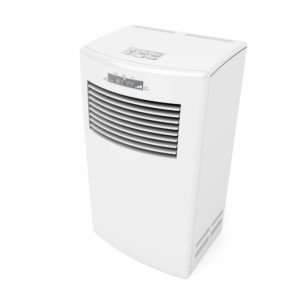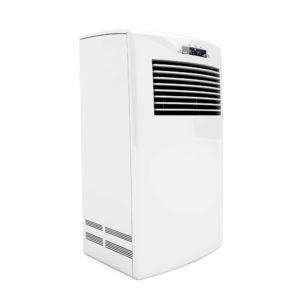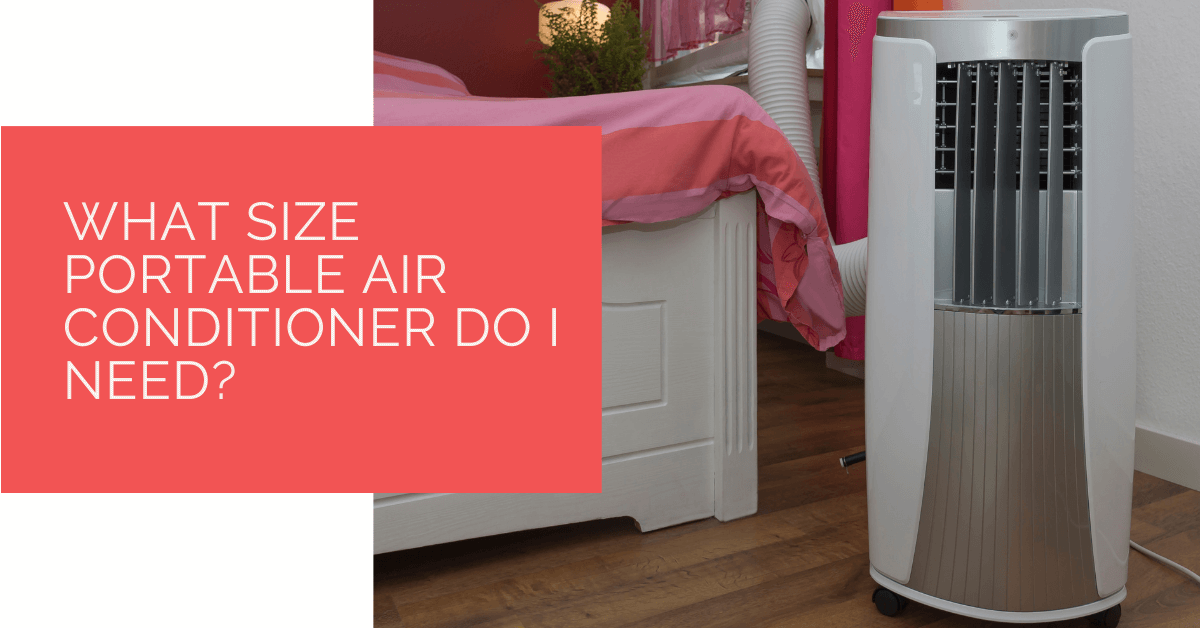Perhaps you want to invest in a portable AC unit because of features like ease of use, efficiency and ventilation. Not to mention, such an air conditioning unit will be versatile due to its manoeuvrability. Either way, these air conditioners can effectively cool your room without requiring significant changes in your home. But, you do not know what portable air conditioners are best for your room size.
Did you know? The British Thermal Unit (measured using BTU/hr) for each air conditioner can denote its actual size. Ideally, you will need portable units that offer 10,000 BTU for a 300 square feet room (24 square/meter) and more than 15,000 BTU for a 500 square feet room (36 square/meter).
Such a portable unit comes in various sizes, shapes and models. Hence, you might find it daunting to choose the right one for your living space.
Luckily for you, the UK has a metric that determines how air conditioners cool one room. Consequently, you can figure out the portable air conditioner size through the cooling power.
Key Takeaways
- Portable air conditioners are a versatile and cost-effective option for cooling single rooms in the UK.
- The British Thermal Unit (BTU) rating determines the size of the portable air conditioner you need, with higher BTU ratings suitable for larger rooms.
- Adjustments to the BTU requirement should consider factors like ceiling height, sunlight exposure, and the number of occupants, making it essential to choose the right unit for your specific space.
What are Portable Air Conditioners?
Portable air conditioning units, also known as PAC, is a device that distributes warm air or cold air through the room. It is a great heat exchanger due to its self-contained portable anatomy, and it can cool single rooms efficiently. Usually, such an air conditioner comes with a self-installation kit that you use to mount on your floor.
 Most portable AC comes with a quick set-up guarantee and wheels. Hence, you can move them to various rooms and utilise the cooled air properly.
Most portable AC comes with a quick set-up guarantee and wheels. Hence, you can move them to various rooms and utilise the cooled air properly.
You need not commit to permanent AC units with the right portable air conditioner. It would be best to choose these devices because they are cheaper and more efficient than regular ACs.
Initially, the cooling capacity in these portable air conditioners is excellent for your specific cooling needs based on the square footage of your home. There are some essential components housed in such an air conditioner, namely:
- Evaporator coil
- Refrigerant
- Condenser coil
- Compressor
The device is better than any split system as it does not require permanent installation. Instead, it can utilise the hot air, cool it down and start the condensation process when switched on.
How to Understand BTU?
BTU is an acronym for British Thermal Units, which calculates the “amount of energy required to enhance the temperature of 1 pound of water 1oF from at sea level.” Usually, it estimates how BTU’s are required hourly for a product to remove air around it.
Your room size will determine the air conditioner size you require. And to choose the size, you need to find out the BTU output requirement.
For example, higher BTU = efficient cooling for larger rooms.
Does this make sense? Technically, higher BTU means larger air conditioners, and it can remove heat from the room appropriately and cool the air. A 5000 to 8000 BTU air conditioning unit, will be good enough for your bedroom in the UK.
On the contrary, your air conditioning units might not be massive if you have a small apartment.
How to Measure BTU for Air Conditioners?
| Room Size | BTU's Needed | Room Size | BTU's Needed |
|---|---|---|---|
| 150 sq. ft. | 5,000 BTU's | 700 sq. ft. | 14,000 BTU's |
| 250 sq. ft. | 6000 BTU's | 1000 sq. ft. | 18,000 BTU's |
| 300 sq. ft. | 7000 BTU's | 1200 sq. ft. | 21,000 BTU's |
| 350 sq. ft. | 8000 BTU's | 1400 sq. ft. | 23,000 BTU's |
| 400 sq. ft. | 9000 BTU's | 1600 sq. ft. | 25,000 BTU's |
| 450 sq. ft. | 10,000 BTU's | 1900 sq. ft. | 28,000 BTU's |
| 550 sq. ft. | 12,000 BTU's | 2700 sq. ft. | 36,000 BTU's |
To measure the precise temperature needed for energy-efficient cooling, you need to measure that particular room in feet (Ironically not meters) and multiply those dimensions by 5.
For example, for a smaller room, your BTU chart should look something like this:
7 Height x 12 Width x 18 Depth (1,512 square feet or 140 square meter) size room multiplied by 5 = 7560 BTUs. Therefore, the single unit air conditioner you need to buy should have the power to make your room colder, such a moderate BTU.
So, how many BTUs are needed on average for any room with an outdoor air supply? Based on this measurement, your portable air conditioner should have a maximum of 7000 BTUs for an average UK room of 18 square/meters. The BTU requirement for hot days will increase as the room sizes increase. For example, a 24 square/meter room will need 10,0000 BTUs, and a 36 square/meter room needs 15,000 BTUs.
Fun Fact: Portable air conditioners use approximately 15 to 20 BTUs for each square meter of the cooling floor space.
Adjustments Required for Portable Air Conditioner
No room in the UK will have similar dimensions; hence the need for an air conditioning unit will remain different. Maybe you want to use the AC unit for cool air, or perhaps you wish to invoke energy efficiency in your entire house, unlike split systems.
Either way, you need to account for factors like high ceilings, sunlight exposure, exhaust hose, central air, and a programmable thermostat.
You can adjust your final BTU based on your needs by taking these factors. The vast majority of your considerations should adhere to these factors:
- More than 2-meter ceiling = BTU increase by 10% for each meter
- Heavily shaded spaces that block out sunlight will need a reduced BTU capacity by 10%
- Sunnier and rooms with more oversized windows should reduce BTU capacity by 10%
- 2 people in the same room space = 600 BTU more for each occupant
- Need a unit for the server room or kitchen? = Increased BTU capacity by 4,000
Note: There are no exact guidelines since environmental factors may or may not decrease or increase the BTU requirements.
Things To Consider Before Choosing a Portable Air Conditioner
 When you are done determining the models to get, it is time for you to analyse the unit and compare it with other models. To get the best models in the country, you need to assess each device intricately.
When you are done determining the models to get, it is time for you to analyse the unit and compare it with other models. To get the best models in the country, you need to assess each device intricately.
Based on your BTU requirement, do not forget to ask questions like:
- What is the actual size of the air conditioning unit?
- Do you need casement windows to place the unit?
- Are there any special maintenance requirements?
- What is the noise level compared to ordinary devices?
You could eventually choose the suitable device with accurate adherence to the BTU measurements, contributing factors and considerations. The entire process will be highly personalised, so the machine you buy will be for your particular space. If you want to avoid inadequate performances, ensure to follow the guidelines properly.
Remember: The energy bill in the UK will get higher if you utilise ACs regularly.
Heat Pump Source: Reliable Heating and Cooling Solutions
At Heat Pump Source, we take pride in our unwavering commitment to serving the UK with top-tier HVAC solutions. From the efficiency of heat pumps and the cool relief of air conditioning to the warmth of boilers, radiators, and underfloor heating, our dedicated team is always at the forefront of innovation. We understand the unique needs of every household and business, and we strive to provide dependable health and cooling products and services that are tailored just for you. Ensuring your comfort and satisfaction is our utmost priority. Whether you have questions, need guidance, or require support, we’re always here to assist. Please don’t hesitate to contact us; we’re eager to be of service.
The Bottom Line
A portable air conditioning unit is better than split systems due to the convenience, specifically designed anatomy and a reduced noise level. Split air conditioning units use more energy to ventilate a small room or office space. However, portable ACs might not charge less on an electricity bill but are cheaper than regular ones.
Not only that, this air conditioning unit comes with remote control, a window kit and a drip tray for the humidifier. At the same time, you can access programmable timers, unlike window ACs that need manual operation.
Even though these ACs cannot ventilate your whole house or several rooms, they can be a good option for smaller spaces and bigger rooms.
All you have to do is get a more extraordinary BTU or a lesser BTU based on your ceiling height and space. On average, you should choose at least 7000 BTU for small apartments or 15,000 BTUs for bigger office spaces.
Whatever you choose, calculate correctly and consider your floor size, temperature, sun exposure, and window size. This way, you can understand how many BTU you require from a portable air conditioner. So, are you ready to install one this season?
About the Author
At Heat Pump Source, our articles are the product of a collaborative effort among a team of highly skilled HVAC experts. Our dedicated professionals, hailing from diverse backgrounds in heating, ventilation, air conditioning, and refrigeration, contribute their extensive knowledge and experience to every piece of content. This multidisciplinary approach ensures comprehensive coverage. Our commitment is to deliver authoritative, reliable, and tailored advice to meet the unique needs of every household and business across the UK.

